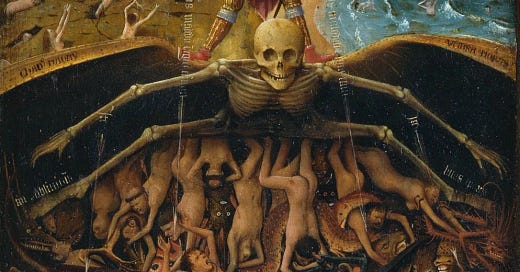Hell
Secularity retreats as Assad's dystopian rule is replaced with a tide of religious fervour
Yes, words can fail. As testimonies rolled in over the past few days it became harder and harder to grasp the hell we were confronted with. It may be better left to artists from the Middle Ages like Jan van Eyck or Hieronymus Bosch to depict the inferno where the last bits of humanity are crushed in the most sadistic ways possible. Evil regimes have always had their systems in place to physically and mentally destroy their real and imagined enemies. And destruction under these circumstances is only the end goal, first body and soul have to be humiliated and crushed. Using whatever satanic tools are available. Only then would the descent in the afterlife be facilitated, in the most cruel way possible.
Over the past few days we have been treated to the hellscape of Sednaya prison, not far from Damascus in Syria, following its liberation. The reports paint a picture of a facility designed to punish, torture and to ultimately destroy the prisoners on a large scale with crematoria readily available. And of course rape, we could even witness disoriented young children born in Sednaya who had never seen the outside world walk out of the prison cells in which they were probably born. This dark hellscape was not visible to the rest of the world, but it is not that we did not know. One of its victims came to tell us this in all its ghastly detail. Mazen al-Hamada returned to Syria and his body was found earlier this week among the many other victims.
So the joy and excitement of the end of one of the world’s most brutal regimes is of course understandable and cause for real celebration. But we would be foolish to delude ourselves in thinking that an Arab Spring is back on and that we can cruise safely to a stabler and safer Syria. We have plenty of case studies to repudiate these rosy scenarios. Saddam Hussein and Muammar Gaddafi were both removed with the goal of creating a better and freer Iraq and Libya, yet Syria may enter same the abyss of uncertainty and violence that have characterized both countries ever since their liberation. Syria is fractured: partly occupied by Turkey, partly controlled by the Kurds, American and Russian troop presences while the victorious forces of Hayʼat Tahrir al-Sham (HTS) now control the country’s heartland. The latter may at some point abandon their happy faces and resort to their darker impulses. Think Taliban, think al-Qaeda.
In a way what we are seeing in Syria is the end of the era of Baathist Arab countries, the socialist and secular nationalist approach to governing in the Middle East. We are sliding into religious fanaticism and while we can celebrate the collapse of the Iran fuelled Shia axis, we now are witnessing a radical Sunni force taking control of the heart of the Middle East. And that is a serious risk for Israel which is why the IDF has pre-emptively been bombing Syrian military facilities to ensure these do not fall into the hands of HTS. Israel’s moment of victory could indeed be brief if a new, Sunni dominated alliances emerges and that would include Hamas who always were an odd partner for Iran’s Shia view of the world.
What is furthermore evident is that the borders that Western powers drew up after the First World War when the Ottoman Empire was dismantled bear very little relationship to the realities on the ground today. We discussed earlier the fate of the stateless Kurds, but also how Turkey and Israel have literally shifted goal posts and in particular in the case of Israel get relentless criticism for it. The West consistently misses its target when engaging in the Middle East in this way and maybe, just maybe, that is because the mindset in Washington, Paris and London is still rooted in hopelessly outdated maps that were drawn up more than a hundred years ago. There may not be a Syria within its recognized borders and there is certainly not an Israel within internationally recognized borders. Watch how Turkey, Israel and Saudi Arabia will and probably should start crafting a newer Middle East that captures the new power arrangements on the ground while providing safety buffers for all parties involved. And in doing so, they will have to ignore those old maps and outdated borders. It is about time.
Yet the quest for newer outlines for the region is increasingly driven by the very sentiments in which Jan van Eyck painted his view of the world in a dark pre-Enlightenment and pre-Reformation world. These were the Middle Ages where religion dominated and governed daily life at the most extreme level, at the expense of everything else. Watch and witness how similar forces are reconstructing a newer and far more traditional Middle East.
Painting: Jan van Eyck (1390-1441), Crucifixion and Last Judgement diptych, 1430–40.



